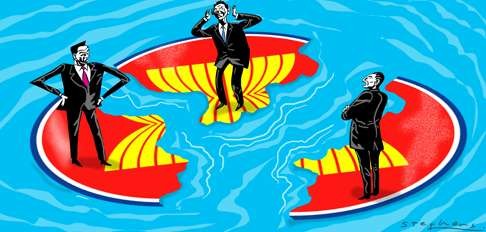
China’s ‘divide and rule’ attitude in Southeast Asia is good for no one, including itself
Michal Thim says Asean countries will be worse off dealing with China on a bilateral basis, while Beijing may not much like the emergence of a Southeast Asia aligned along US- or China-led groupings

Granted, the Association of Southeast Asian Nations is not known for sustaining unity in the face of pressure, and it is hardly a surprise to long-time observers that arguably the most significant organisation of regional integration has failed to reflect on the latest developments in the South China Sea. To wit: the July 24 joint communiqué adopted during the Asean foreign ministers’ meeting in Laos avoided the obvious elephant in the room: the ruling of The Hague tribunal that delivered a legal blow to Beijing’s South China Sea claims.

PLA Air Force holds fresh patrols in South China Sea as it seeks to ‘normalise’ stepped-up surveillance
Prior to the ruling, Beijing had attempted to discredit the legitimacy of the court. It was more or less clear that the ruling would not be favourable. Thus, China made it equally clear that it would not be pleased to hear a word about the ruling. That The Hague decision is nothing short of a worst-case scenario further encourages Chinese efforts to double down on denying the obvious.
Since July 12, Beijing has had two opportunities to push back. Before this year’s Asean foreign ministers’ meeting, there was the annual Asia-Europe Meeting summit on July 15-16 in the Mongolian capital of Ulan Bator. Attempts were made to include references to the South China Sea and The Hague ruling but the request was flatly rejected. This was not surprising, considering that the meeting is typically more focused on matters of consensus. But while this is an informal forum for European and Asian countries, Asean has a more ambitious long-term outlook. Thus, its refusal to address the issue is of greater consequence. The fact that both the US and China dispatched their foreign ministers to this year’s Asean meeting testified to its importance.

In the South China Sea, Beijing is a big fish in a small pond
It speaks volumes about the divide within Asean and Beijing’s influence on some members, particularly Laos and Cambodia (two states which have virtually no stake in the dispute and strongly wish to avoid China’s wrath), that the foreign ministers’ issuing a joint statement of any kind was considered a positive outcome. In fact, at one point, ministers were close to issuing no statement, thus repeating the situation in July 2012 when Cambodia blocked a joint statement over the proposed inclusion of South China Sea developments. Four years later, the same result was avoided only because the Philippines decided to withdraw the proposal to mention the ruling, instead leaving the declaration with a vague note expressing the concerns of “some ministers” over island-building.
If Asean does not reflect upon major developments in the South China Sea affecting its membership, who else will?
Whether the withdrawal by Manila was the result of the majority not being very eager to include the reference, as some sources claim, or Cambodia engaging in “hostage-taking”, as others say, is beside the point. If Asean does not reflect upon major developments in the South China Sea affecting a large portion of its membership, who else will? The foreign ministers’ statement did not even include some generic reference stressing the importance of adhering to international law for regional stability.
So far, so good for Beijing.
There is no doubt that China’s “divide and conquer” attitude toward Asean unity on political issues is effective. Supporting economic cooperation while preventing the emergence of a unified bloc that could hold its ground against China with greater confidence than any individual nation could plays out rather well for Beijing. Moreover, while the significance of the tribunal’s ruling is legal and will materialise over the long term, China is managing immediate perceptions, in which it is sufficient to demonstrate that the ruling has no immediate implications.
The foreign ministers’ non-statement is a great victory for Chinese diplomacy. One may be inclined to assume that it is bad for Manila and Washington, which lobbied strongly for a reference to the ruling. Instead, the real loser is Asean as a whole, and prospects for closer regional integration.

On South China Sea disputes, politicians should step up where legal scholars have failed
Hardly anyone can blame China for trying to win over individual Asean members if they are so eager to be won over. Member states must realise that unity serves them all better. There is no way that dealing with Beijing on a bilateral basis will produce better results than getting Beijing to deal with the bloc as one. Thus far, Asean has worked on the premise that it can focus on removing trade barriers and engaging in cooperation on non-traditional security issues while leaving aside thorny issues – including territorial disputes between members and Beijing. The folly of such an approach should be beyond obvious by now.
Beijing can be satisfied. However, there could be unintended consequences. Dividing Asean might well create conditions where member states will no longer bother with the grouping and opt to align with like-minded countries instead. Only the decision-makers in Zhongnanhai know if a semi-permanent division into China- and US-led blocks would be better than dealing with Asean as a whole, even if it sometimes acts in a way that does not support Chinese interests.
Coming to a consensus to issue a joint statement was a good move, but not good enough. It is a consensus that Asean deserves, but not the one it needs right now.
Michal Thim is a Taiwan analyst at the Prague-based think tank, Association for International Affairs, and a member of the Centre for International Maritime Security

